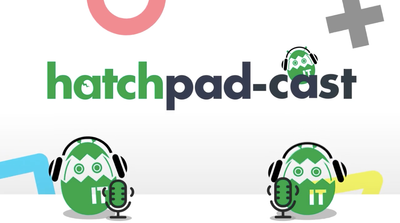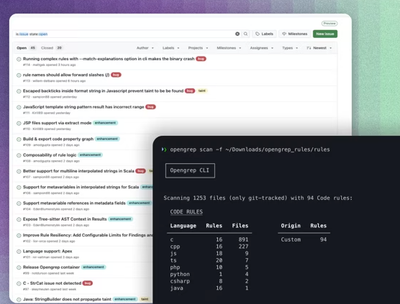
Research
Security News
Lazarus Strikes npm Again with New Wave of Malicious Packages
The Socket Research Team has discovered six new malicious npm packages linked to North Korea’s Lazarus Group, designed to steal credentials and deploy backdoors.
@semantic-release/github
Advanced tools
semantic-release plugin to publish a GitHub release and comment on released Pull Requests/Issues
The @semantic-release/github package is designed to automate the release process of your GitHub projects by integrating with semantic versioning. It helps in publishing GitHub releases, managing release notes, and handling assets and pre-releases seamlessly. This package is part of the semantic-release ecosystem, which automates versioning and package publishing.
Publish GitHub Releases
Automatically publish a GitHub release with assets. The configuration allows you to specify which assets to include in the release, such as compiled binaries or distribution packages.
"@semantic-release/github": {
"assets": [
{"path": "build/zip/your-package.zip", "label": "Your Package"}
]
}Comment on Released Pull Requests and Issues
Automatically comment on the GitHub issues and pull requests that are part of the release. This feature helps in notifying contributors and users about the resolution of issues and the availability of new versions.
"@semantic-release/github": {
"successComment": "This issue has been resolved in version \\$VERSION"
}Add Labels to Pull Requests
Automatically add labels to the pull requests included in the release. This can help in tracking the release status of various changes and organizing pull requests.
"@semantic-release/github": {
"releasedLabels": ["Status: Released", "\"\\$VERSION\""]
}Similar to @semantic-release/github, standard-version automates versioning and CHANGELOG generation, but it does so without relying on a continuous integration server. It's more suited for manual releases and doesn't directly integrate with GitHub releases.
Release-it is a versatile tool for automating versioning and package publishing, similar to @semantic-release/github. It supports various platforms including GitHub, GitLab, and Bitbucket. Unlike @semantic-release/github, it provides a more interactive release process and can be customized for different workflows.
Lerna is a tool for managing JavaScript projects with multiple packages, making it somewhat similar to @semantic-release/github in terms of release management. It automates the versioning and publishing process for monorepos. While it can work alongside semantic-release for complex workflows, it's primarily focused on monorepo management rather than direct GitHub integration.
semantic-release plugin to publish a GitHub release and comment on released Pull Requests/Issues.
| Step | Description |
|---|---|
verifyConditions | Verify the presence and the validity of the authentication (set via environment variables) and the assets option configuration. |
publish | Publish a GitHub release, optionally uploading file assets. |
addChannel | Update a GitHub release's pre-release field. |
success | Add a comment to each GitHub Issue or Pull Request resolved by the release and close issues previously open by the fail step. |
fail | Open or update a GitHub Issue with information about the errors that caused the release to fail. |
$ npm install @semantic-release/github -D
The plugin can be configured in the semantic-release configuration file:
{
"plugins": [
"@semantic-release/commit-analyzer",
"@semantic-release/release-notes-generator",
[
"@semantic-release/github",
{
"assets": [
{ "path": "dist/asset.min.css", "label": "CSS distribution" },
{ "path": "dist/asset.min.js", "label": "JS distribution" }
]
}
]
]
}
With this example GitHub releases will be published with the file dist/asset.min.css and dist/asset.min.js.
The GitHub authentication configuration is required and can be set via environment variables.
Follow the Creating a personal access token for the command line documentation to obtain an authentication token. The token has to be made available in your CI environment via the GH_TOKEN environment variable. The user associated with the token must have push permission to the repository.
When creating the token, the minimum required scopes are:
repo for a private repositorypublic_repo for a public repositoryNote on GitHub Actions: You can use the default token which is provided in the secret GITHUB_TOKEN. However releases done with this token will NOT trigger release events to start other workflows. If you have actions that trigger on newly created releases, please use a generated token for that and store it in your repository's secrets (any other name than GITHUB_TOKEN is fine).
When using the GITHUB_TOKEN, the minimum required permissions are:
contents: write to be able to publish a GitHub releaseissues: write to be able to comment on released issuespull-requests: write to be able to comment on released pull requests| Variable | Description |
|---|---|
GITHUB_TOKEN or GH_TOKEN | Required. The token used to authenticate with GitHub. |
GITHUB_URL or GH_URL | The GitHub server endpoint. |
GITHUB_PREFIX or GH_PREFIX | The GitHub API prefix, relative to GITHUB_URL. |
GITHUB_API_URL | The GitHub API endpoint. Note that this overwrites GITHUB_PREFIX. |
| Option | Description | Default |
|---|---|---|
githubUrl | The GitHub server endpoint. | GH_URL or GITHUB_URL environment variable. |
githubApiPathPrefix | The GitHub API prefix, relative to githubUrl. | GH_PREFIX or GITHUB_PREFIX environment variable. |
githubApiUrl | The GitHub API endpoint. Note that this overwrites githubApiPathPrefix. | GITHUB_API_URL environment variable. |
proxy | The proxy to use to access the GitHub API. Set to false to disable usage of proxy. See proxy. | HTTP_PROXY environment variable. |
assets | An array of files to upload to the release. See assets. | - |
successComment | The comment to add to each issue and pull request resolved by the release. Set to false to disable commenting on issues and pull requests. See successComment. | :tada: This issue has been resolved in version ${nextRelease.version} :tada:\n\nThe release is available on [GitHub release](<github_release_url>) |
successCommentCondition | Use this as condition, when to comment on issues or pull requests. See successCommentCondition | - |
failComment | The content of the issue created when a release fails. Set to false to disable opening an issue when a release fails. See failComment. | Friendly message with links to semantic-release documentation and support, with the list of errors that caused the release to fail. |
failTitle | The title of the issue created when a release fails. Set to false to disable opening an issue when a release fails. | The automated release is failing 🚨 |
failCommentCondition | Use this as condition, when to comment on or create an issues in case of failures. See failCommentCondition. | - |
labels | The labels to add to the issue created when a release fails. Set to false to not add any label. | ['semantic-release'] |
assignees | The assignees to add to the issue created when a release fails. | - |
releasedLabels | The labels to add to each issue and pull request resolved by the release. Set to false to not add any label. See releasedLabels. | ['released<%= nextRelease.channel ? \ on @${nextRelease.channel}` : "" %>']- |
addReleases | Will add release links to the GitHub Release. Can be false, "bottom" or "top". See addReleases. | false |
draftRelease | A boolean indicating if a GitHub Draft Release should be created instead of publishing an actual GitHub Release. | false |
releaseNameTemplate | A Lodash template to customize the github release's name | <%= nextverison.name %> |
releaseBodyTemplate | A Lodash template to customize the github release's body | <%= nextverison.notes %> |
discussionCategoryName | The category name in which to create a linked discussion to the release. Set to false to disable creating discussion for a release. | false |
Can be false, a proxy URL or an Object with the following properties:
| Property | Description | Default |
|---|---|---|
host | Required. Proxy host to connect to. | - |
port | Required. Proxy port to connect to. | File name extracted from the path. |
secureProxy | If true, then use TLS to connect to the proxy. | false |
headers | Additional HTTP headers to be sent on the HTTP CONNECT method. | - |
See node-https-proxy-agent and node-http-proxy-agent for additional details.
'http://168.63.76.32:3128': use the proxy running on host 168.63.76.32 and port 3128 for each GitHub API request.
{host: '168.63.76.32', port: 3128, headers: {Foo: 'bar'}}: use the proxy running on host 168.63.76.32 and port 3128 for each GitHub API request, setting the Foo header value to bar.
Can be a glob or and Array of
globs and Objects with the following properties:
| Property | Description | Default |
|---|---|---|
path | Required. A glob to identify the files to upload. | - |
name | The name of the downloadable file on the GitHub release. | File name extracted from the path. |
label | Short description of the file displayed on the GitHub release. | - |
Each entry in the assets Array is globbed individually. A glob
can be a String ("dist/**/*.js" or "dist/mylib.js") or an Array of Strings that will be globbed together
(["dist/**", "!**/*.css"]).
If a directory is configured, all the files under this directory and its children will be included.
The name and label for each assets are generated with Lodash template. The following variables are available:
| Parameter | Description |
|---|---|
branch | The branch from which the release is done. |
lastRelease | Object with version, gitTag and gitHead of the last release. |
nextRelease | Object with version, gitTag, gitHead and notes of the release being done. |
commits | Array of commit Objects with hash, subject, body message and author. |
Note: If a file has a match in assets it will be included even if it also has a match in .gitignore.
'dist/*.js': include all the js files in the dist directory, but not in its sub-directories.
[['dist', '!**/*.css']]: include all the files in the dist directory and its sub-directories excluding the css
files.
[{path: 'dist/MyLibrary.js', label: 'MyLibrary JS distribution'}, {path: 'dist/MyLibrary.css', label: 'MyLibrary CSS distribution'}]: include the dist/MyLibrary.js and dist/MyLibrary.css files, and label them MyLibrary JS distribution and MyLibrary CSS distribution in the GitHub release.
[['dist/**/*.{js,css}', '!**/*.min.*'], {path: 'build/MyLibrary.zip', label: 'MyLibrary'}]: include all the js and
css files in the dist directory and its sub-directories excluding the minified version, plus the
build/MyLibrary.zip file and label it MyLibrary in the GitHub release.
[{path: 'dist/MyLibrary.js', name: 'MyLibrary-${nextRelease.gitTag}.js', label: 'MyLibrary JS (${nextRelease.gitTag}) distribution'}]: include the file dist/MyLibrary.js and upload it to the GitHub release with name MyLibrary-v1.0.0.js and label MyLibrary JS (v1.0.0) distribution which will generate the link:
[MyLibrary JS (v1.0.0) distribution](MyLibrary-v1.0.0.js)
The message for the issue comments is generated with Lodash template. The following variables are available:
| Parameter | Description |
|---|---|
branch | Object with name, type, channel, range and prerelease properties of the branch from which the release is done. |
lastRelease | Object with version, channel, gitTag and gitHead of the last release. |
nextRelease | Object with version, channel, gitTag, gitHead and notes of the release being done. |
commits | Array of commit Objects with hash, subject, body message and author. |
releases | Array with a release Objects for each release published, with optional release data such as name and url. |
issue | A GitHub API pull request object for pull requests related to a commit, or GitHub API issue object for issues resolved via keywords |
The successComment This ${issue.pull_request ? 'pull request' : 'issue'} is included in version ${nextRelease.version} will generate the comment:
This pull request is included in version 1.0.0
The message for the issue comments is generated with Lodash template. The following variables are available:
| Parameter | Description |
|---|---|
branch | Object with name, type, channel, range and prerelease properties of the branch from which the release is done. |
lastRelease | Object with version, channel, gitTag and gitHead of the last release. |
nextRelease | Object with version, channel, gitTag, gitHead and notes of the release being done. |
commits | Array of commit Objects with hash, subject, body message and author. |
releases | Array with a release Objects for each release published, with optional release data such as name and url. |
issue | A GitHub API Pull Request object for pull requests related to a commit |
false or templating: "<% return false; %>""<% return !issue.pull_request; %>""<% return issue.pull_request; %>""<% return issue.user.type !== 'Bot'; %>""<% return issue.labels?.some((label) => { return label.name === ('semantic-release-relevant'); }); %>"check the GitHub API issue object for properties which can be used for the filter
The message for the issue content is generated with Lodash template. The following variables are available:
| Parameter | Description |
|---|---|
branch | The branch from which the release had failed. |
errors | An Array of SemanticReleaseError. Each error has the message, code, pluginName and details properties.pluginName contains the package name of the plugin that threw the error.details contains a information about the error formatted in markdown. |
The failComment This release from branch ${branch.name} had failed due to the following errors:\n- ${errors.map(err => err.message).join('\\n- ')} will generate the comment:
This release from branch master had failed due to the following errors:
- Error message 1
- Error message 2
The message for the issue content is generated with Lodash template. The following variables are available:
| Parameter | Description |
|---|---|
branch | Object with name, type, channel, range and prerelease properties of the branch from which the release is done. |
lastRelease | Object with version, channel, gitTag and gitHead of the last release. |
nextRelease | Object with version, channel, gitTag, gitHead and notes of the release being done. |
commits | Array of commit Objects with hash, subject, body message and author. |
releases | Array with a release Objects for each release published, with optional release data such as name and url. |
issue | A GitHub API pull request object for pull requests related to a commit, or GitHub API issue object for issues resolved via keywords |
false or templating: "<% return false; %>""<% return branch.name === 'main' %>"wip: "<% return !issue.labels?.includes('wip') %>"check the GitHub API Pull Request Object for properties which can be used for the filter
Each label name is generated with Lodash template. The following variables are available:
| Parameter | Description |
|---|---|
branch | Object with name, type, channel, range and prerelease properties of the branch from which the release is done. |
lastRelease | Object with version, channel, gitTag and gitHead of the last release. |
nextRelease | Object with version, channel, gitTag, gitHead and notes of the release being done. |
commits | Array of commit Objects with hash, subject, body message and author. |
releases | Array with a release Objects for each release published, with optional release data such as name and url. |
issue | A GitHub API pull request object for pull requests related to a commit, or GitHub API issue object for issues resolved via keywords |
The releasedLabels ['released<%= nextRelease.channel ? ` on @\${nextRelease.channel}` : "" %> from <%= branch.name %>'] will generate the label:
released on @next from branch next
Add links to other releases to the GitHub release body.
Valid values for this option are false, "top" or "bottom".
See The introducing PR for an example on how it will look.
FAQs
semantic-release plugin to publish a GitHub release and comment on released Pull Requests/Issues
We found that @semantic-release/github demonstrated a healthy version release cadence and project activity because the last version was released less than a year ago. It has 4 open source maintainers collaborating on the project.
Did you know?

Socket for GitHub automatically highlights issues in each pull request and monitors the health of all your open source dependencies. Discover the contents of your packages and block harmful activity before you install or update your dependencies.

Research
Security News
The Socket Research Team has discovered six new malicious npm packages linked to North Korea’s Lazarus Group, designed to steal credentials and deploy backdoors.

Security News
Socket CEO Feross Aboukhadijeh discusses the open web, open source security, and how Socket tackles software supply chain attacks on The Pair Program podcast.

Security News
Opengrep continues building momentum with the alpha release of its Playground tool, demonstrating the project's rapid evolution just two months after its initial launch.